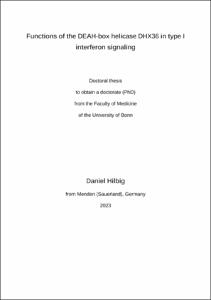Functions of the DEAH-box helicase DHX36 in type I interferon signaling

Functions of the DEAH-box helicase DHX36 in type I interferon signaling

| dc.contributor.advisor | Paeschke, Katrin | |
| dc.contributor.author | Hilbig, Daniel | |
| dc.date.accessioned | 2023-01-06T11:06:48Z | |
| dc.date.available | 2025-01-15T23:00:54Z | |
| dc.date.issued | 06.01.2023 | |
| dc.identifier.uri | https://hdl.handle.net/20.500.11811/10568 | |
| dc.description.abstract | The induction of type I interferons (IFN) is a hallmark of foreign nucleic acids immune sensing by the innate immune system. Based on the universal molecular structure of DNA and RNA throughout all kingdoms of life, the cell has to distinguish foreign nucleic acids from self-nucleic acids to properly respond to infecting pathogens. Thus, the orchestration of this crucial process, in which the cell has to balance the tolerance to endogenous nucleic acids, is achieved by a sophisticated network of receptor proteins as well as their negative and positive regulators.
A pivotal factor against viral RNA are cytoplasmic localized pattern recognition receptors (PRRs) as well as other proteins that detect specific structures of foreign RNA and induce a myriad of signaling cascades. The activation of PRRs upon viral RNA recognition results in the expression of IFNs and subsequently, the induction of interferon stimulated genes (ISGs) to impair viral spread. One example of anti-viral proteins is the DEAH-box helicase DHX36. While described in several reports, the exact mechanism how and where this protein acts in the type I IFN signaling remains still elusive. The here-presented doctoral thesis provides a detailed view on the specific function of the helicase DHX36 during viral stress in human embryonic kidney cells. The expression pattern of DHX36, its interactions to other proteins, as well as epistatic affiliations were analyzed. The sensing of viral RNA leads to the downregulation of DHX36 expression, which normally stays in an RNA-dependent complex with PKR and ADAR1. The loss of DHX36 is accompanied by a slight increase in type I IFN genes and ISGs in unchallenged conditions, while a viral trigger massively induces their expression compared to WT cells. The positive effect of the DHX36 depletion on increased ISGs is congruent with a decrease in yellow fever virus replicon replication and an enhanced cell metabolism during viral stress. Furthermore, the increase of ISGs during viral RNA recognition completely depends on PKR, while the enhanced type I IFN signaling is independent of PKR. I hypothesize that, DHX36 is a negative regulator of PKR and maybe other PRRs to control and orchestrate self-tolerance to endogenous RNA and correct activation of them during viral RNA detection. | en |
| dc.language.iso | eng | |
| dc.rights | In Copyright | |
| dc.rights.uri | http://rightsstatements.org/vocab/InC/1.0/ | |
| dc.subject | DHX36 | |
| dc.subject | Interferon | |
| dc.subject | Virus | |
| dc.subject | RIG-I | |
| dc.subject | PKR | |
| dc.subject | Helicase | |
| dc.subject.ddc | 570 Biowissenschaften, Biologie | |
| dc.subject.ddc | 610 Medizin, Gesundheit | |
| dc.title | Functions of the DEAH-box helicase DHX36 in type I interferon signaling | |
| dc.type | Dissertation oder Habilitation | |
| dc.publisher.name | Universitäts- und Landesbibliothek Bonn | |
| dc.publisher.location | Bonn | |
| dc.rights.accessRights | openAccess | |
| dc.identifier.urn | https://nbn-resolving.org/urn:nbn:de:hbz:5-69107 | |
| ulbbn.pubtype | Erstveröffentlichung | |
| ulbbnediss.affiliation.name | Rheinische Friedrich-Wilhelms-Universität Bonn | |
| ulbbnediss.affiliation.location | Bonn | |
| ulbbnediss.thesis.level | Dissertation | |
| ulbbnediss.dissID | 6910 | |
| ulbbnediss.date.accepted | 27.10.2022 | |
| ulbbnediss.institute | Medizinische Fakultät / Kliniken : Medizinische Klinik und Poliklinik III - Innere Medizin | |
| ulbbnediss.fakultaet | Medizinische Fakultät | |
| dc.contributor.coReferee | Gruß, Oliver | |
| ulbbnediss.date.embargoEndDate | 15.01.2025 | |
| ulbbnediss.contributor.gnd | 1372762124 |
Dateien zu dieser Ressource
Das Dokument erscheint in:
-
E-Dissertationen (2079)




